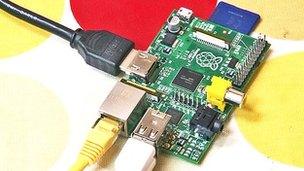Ripples from the Raspberry Pi
- Published
- comments
Computer scientist Eben Upton on Raspberry Pi's new camera
In May last year, video games entrepreneur David Braben and Cambridge computer scientist Eben Upton came to see me with the prototype of a new computer. It was about the size of a USB stick, it was called Raspberry Pi, and its aim was to inspire a new generation of children to get interested in computer science.
The simple video I shot of the device, external on my phone eventually attracted more than 800,000 views on YouTube.
Fifteen months on, the project has taken off in a way its creators never imagined, and the ripples from the Raspberry Pi keep spreading out. When the Pi - slightly larger than the one I was shown last year - launched at the end of February, there was a huge response, and the charity behind it is still struggling to cope with the demand.
Two companies, RS and Farnell, have been contracted to distribute the mini-computers, and last week Electrocomponents, the RS parent company, reported that booming sales of the Raspberry Pi had boosted its first quarter revenues.
On Saturday I went along to a Raspberry Jam in Cambridge, the latest in a series of events where enthusiasts gather to discuss the project, swap experiences and hear about what may be coming next.
The audience at the sell-out event heard some breaking news from Eben Upton. Production had ramped up to 4,000 units a day to meet demand, but there was still a backlog of orders.
But what really excited the crowd was the announcement that a camera module for the device was coming very soon, priced at $20-$25 and offering 5MP photos and good quality video.
"It's been completely crazy," Eben Upton told me afterwards. "At Christmas last year we thought we might sell 10,000 of these devices, so to be sitting here with 200,000 out in the wild and plans to get to a million by the end of the year is just incredible."
But what is extraordinary about this project is the ecosystem (to use a fashionable word) which is being constructed around it. We heard from various organisations with plans to use the device - from the London Zoo which hopes to use the Raspberry Pi and its new camera in a project to crowd source the mapping of endangered animals - to various companies making components to offer greater functionality to the device. We saw a presentation by 18-year-old Liam Fraser whose YouTube channel offering Raspberry Pi tutorials, external has already had over a million views.

Raspberry Pi runs off an operating system on an attached SD memory card
The Raspberry Pi Foundation is a charity but Liz Upton, who runs the forums, answers the emails, and generally does an amazing job of nurturing the Pi community, told us the organisation was very relaxed about companies making tons of money from picking up the idea and running with it.
The lecture theatre at the Cambridge Computing lab where the event took place was packed with teachers, some with deep knowledge of computer science, others just eager to work out how what difference the device could make in their schools.
And, amidst all the enthusiasm for this project amongst a largely middle-aged crowd, it is important to remember exactly who it is aimed at - school children.
The most telling presentation was by Dr Andrew Robinson from Manchester University's PiFace project, external, which is providing resources for schools. "Children are experts in time management," he told us. "You've got 10 seconds to get them to say 'wow'. Longer than that, and you may have lost them." Once you've got their interest, he explained, you can get them to do more.
That rings true. A generation is growing up used to technology which just works straight out of the box without demanding much expertise from the user. Expert and enthusiastic teachers will be needed to realise the vision behind Raspberry Pi.
But here's another idea. Do as I did and take a somewhat cynical teenager to a Raspberry Jam event. You might be surprised at their reaction, and might even hear them say "wow".